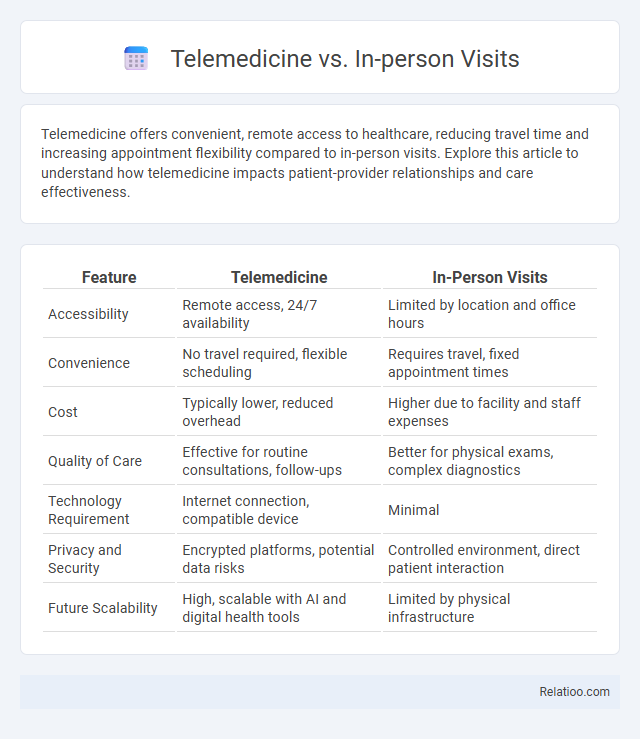Telemedicine offers convenient, remote access to healthcare, reducing travel time and increasing appointment flexibility compared to in-person visits. Explore this article to understand how telemedicine impacts patient-provider relationships and care effectiveness.
Table of Comparison
| Feature | Telemedicine | In-Person Visits |
|---|---|---|
| Accessibility | Remote access, 24/7 availability | Limited by location and office hours |
| Convenience | No travel required, flexible scheduling | Requires travel, fixed appointment times |
| Cost | Typically lower, reduced overhead | Higher due to facility and staff expenses |
| Quality of Care | Effective for routine consultations, follow-ups | Better for physical exams, complex diagnostics |
| Technology Requirement | Internet connection, compatible device | Minimal |
| Privacy and Security | Encrypted platforms, potential data risks | Controlled environment, direct patient interaction |
| Future Scalability | High, scalable with AI and digital health tools | Limited by physical infrastructure |
Introduction: Defining Telemedicine and In-Person Visits
Telemedicine involves the remote delivery of healthcare services using digital communication technologies, enabling patients to consult with healthcare providers without physical presence. In-person visits require patients to travel to healthcare facilities for face-to-face examination and treatment, allowing direct interaction and hands-on procedures. Both approaches play crucial roles in managing health crises by improving access, reducing exposure risks, and ensuring continuity of care.
Evolution of Healthcare: Rise of Telemedicine
The evolution of healthcare has accelerated with the rise of telemedicine, offering a convenient alternative to traditional in-person visits by enabling remote diagnosis, treatment, and monitoring through digital technology. Telemedicine reduces barriers related to geographic location, time constraints, and healthcare accessibility, especially during health crises like pandemics where in-person visits pose significant risks. Your ability to access timely care improves dramatically as healthcare systems integrate telemedicine platforms, ensuring continuity and efficiency even during periods of strained medical resources.
Accessibility and Convenience for Patients
Telemedicine significantly enhances accessibility and convenience by allowing patients to receive medical consultations from any location, eliminating travel time and reducing wait times compared to in-person visits. During health crises such as pandemics, telemedicine mitigates risk of infection while ensuring continuous care for patients with chronic conditions or mild symptoms. In contrast, in-person visits remain essential for physical examinations and procedures but may present barriers due to geographic, mobility, or scheduling constraints.
Quality of Care: Comparing Telemedicine and In-Person Visits
Telemedicine offers convenient access to healthcare, maintaining quality of care by enabling remote diagnosis and treatment through video consultations and digital monitoring tools. In-person visits provide hands-on examinations and immediate diagnostic tests that are crucial for complex conditions, ensuring thorough physical assessments and personalized care. Your choice between telemedicine and in-person visits should consider the severity of the health issue, as telemedicine excels in routine check-ups while in-person care is essential during health crises for comprehensive evaluation.
Technology Requirements and Digital Literacy
Telemedicine demands reliable high-speed internet, secure video conferencing platforms, and compatible devices, which may challenge individuals with limited digital literacy or inadequate technology access. In-person visits require minimal technology but can pose barriers during a health crisis when physical distancing and overwhelmed facilities restrict access. Your ability to navigate telehealth platforms directly impacts care quality, emphasizing the need for user-friendly interfaces and digital literacy training during a health crisis.
Privacy and Data Security Concerns
Telemedicine platforms must implement robust encryption protocols and secure authentication methods to protect patient data from cyber threats, especially during health crises when digital consultations surge. In-person visits, while offering physical security advantages, still require stringent management of electronic health records to prevent unauthorized access. Privacy concerns intensify in health crises due to increased data sharing and rapid system integrations, necessitating comprehensive compliance with HIPAA and GDPR standards to safeguard sensitive patient information.
Cost Considerations: Telemedicine vs In-Person
Telemedicine significantly reduces costs by eliminating travel expenses, minimizing time off work, and lowering overhead for healthcare providers compared to traditional in-person visits. In contrast, in-person consultations often incur higher charges due to facility fees, longer appointment times, and resource utilization, especially during health crises when demand surges. Cost considerations favor telemedicine as a scalable, budget-friendly alternative that maintains care quality while addressing financial constraints in healthcare delivery.
Situations Best Suited for Each Approach
Telemedicine is best suited for non-emergency consultations, prescription refills, and follow-ups, offering convenience and quick access to healthcare professionals. In-person visits are essential for physical examinations, diagnostic tests, and treatments requiring direct intervention or urgent care. During a health crisis, such as a pandemic, telemedicine reduces infection risks while in-person visits address critical and severe medical conditions, ensuring your safety and comprehensive care.
Patient and Provider Perspectives
Telemedicine offers patients enhanced access to healthcare by minimizing travel time and exposure risks during health crises, while providers can efficiently manage caseloads and reduce facility strain. In-person visits enable thorough physical examinations and immediate diagnostic testing, critical for accurate assessments, but may increase infection risk and logistical challenges. Both modalities require balanced integration to optimize patient outcomes and provider workflow, especially under strained healthcare systems during pandemics or emergency situations.
Future Trends in Hybrid Healthcare Models
Telemedicine and in-person visits are evolving into hybrid healthcare models that combine digital convenience with physical care to address ongoing health crises effectively. Your access to seamless virtual consultations and timely in-person treatments will increase as healthcare providers integrate advanced AI diagnostics and remote monitoring technologies. Future trends emphasize personalized care coordination, reducing hospital overcrowding while ensuring comprehensive health management across diverse patient needs.

Infographic: Telemedicine vs In-person visits
 relatioo.com
relatioo.com